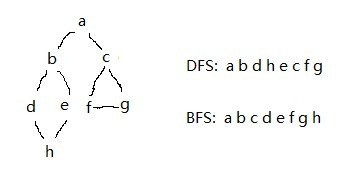图的深度优先和广度优先算法(DFS递归与非递归)
2010-06-21 17:52
483 查看
本博客前面文章已对图有过简单的介绍,本文主要是重点介绍有关图的一些具体操作与应用
阅读本文前,可以先参考本博客 各种基本算法实现小结(四)—— 图及其遍历
和
图的一些基本算法
无向图——邻接矩阵的深度优先和广度优先算法实现
测试环境:VS2008(C)
运行结果:


阅读本文前,可以先参考本博客 各种基本算法实现小结(四)—— 图及其遍历
和
图的一些基本算法
无向图——邻接矩阵的深度优先和广度优先算法实现
测试环境:VS2008(C)
#include "stdafx.h"
#include <stdlib.h>
#include <malloc.h>
#define INFINITY INT_MAX
#define MAX_VEX 20
#define VRType int
#define VertexType char
#define InfoType int
int *visited;
/********************************/
/**** 图的结构定义 ****/
/********************************/
typedef enum
{
DG,
DN,
UDG,
UDN
}GraphKind;
struct _ArcCell
{
VRType adj; /* note weight */
InfoType *info;
};
typedef struct _ArcCell ArcCell, AdjMatrix[MAX_VEX][MAX_VEX];
struct _MGraph
{
VertexType vexs[MAX_VEX];
AdjMatrix arcs;
int vexnum, arcnum;
GraphKind kind;
};
typedef struct _MGraph MGraph;
/********************************/
/**** 栈的结构定义 ****/
/********************************/
struct _node
{
int ivex;
struct _node *next;
};
typedef struct _node node, *pnode;
struct _stack
{
int size;
pnode ptop;
};
typedef struct _stack stack, *pstack;
/********************************/
/**** 堆的结构定义 ****/
/********************************/
struct _queue
{
pnode front;
pnode rear;
};
typedef struct _queue queue, *pqueue;
/********************************/
/**** 栈的实现 ****/
/********************************/
pstack init_stack(int size)
{
pnode pn=NULL;
pstack ps=NULL;
pn=(pnode)malloc(sizeof(node));
ps=(pstack)malloc(sizeof(stack));
pn->ivex=-1;
pn->next=NULL;
ps->size=size;
ps->ptop=pn;
return ps;
}
int empty_stack(pstack ps)
{
if(ps->ptop->next==NULL)
return 1;
else
return 0;
}
void push_stack(pstack ps, int ivex)
{
pnode pn=NULL;
pn=(pnode)malloc(sizeof(node));
pn->ivex=ivex;
pn->next=ps->ptop;
ps->ptop=pn;
}
int pop_stack(pstack ps)
{
int ivex=-1;
pnode pn=NULL;
if(!empty_stack(ps))
{
pn=ps->ptop;
ps->ptop=ps->ptop->next;
ivex=pn->ivex;
free(pn);
}
return ivex;
}
/********************************/
/**** 堆的实现 ****/
/********************************/
queue init_queue()
{
pnode pn=NULL;
queue qu;
pn=(pnode)malloc(sizeof(node));
pn->next;
pn->ivex=-1;
qu.front=qu.rear=pn;
return qu;
}
int empty_queue(queue qu)
{
if(qu.front==qu.rear)
return 1;
else
return 0;
}
void en_queue(queue qu, int ivex)
{
pnode pn=NULL;
pn=(pnode)malloc(sizeof(node));
pn->ivex=ivex;
pn->next=qu.rear->next;
qu.rear=pn;
}
int de_queue(queue qu)
{
int ivex=-1;
pnode pn=NULL;
if(!empty_queue(qu))
{
pn=qu.front;
qu.front=qu.front->next;
ivex=pn->ivex;
free(pn);
}
return ivex;
}
/********************************/
/**** 图的实现 ****/
/********************************/
int LocateVex(MGraph g, char ch)
{
int i;
for(i=1; i<=g.vexnum; i++)
if(ch==g.vexs[i])
return i;
return -1;
}
MGraph Create_UDG()
{
int i, j, w, p1, p2;
char ch1, ch2;
MGraph g;
printf("Enter vexnum arcnum: ");
scanf("%d %d", &g.vexnum, &g.arcnum);
getchar();
for(i=1; i<=g.vexnum; i++)
for(j=1; j<=g.vexnum; j++)
g.arcs[i][j].adj=g.arcs[j][i].adj=INFINITY; /* UDG should define i-j and j-i */
printf("Enter %d vex.../n", g.vexnum);
for(i=1; i<=g.vexnum; i++)
{
printf("vex %d: ", i);
scanf("%c", &g.vexs[i]);
getchar();
}
printf("Enter %d arc.../n", g.arcnum);
for(i=1; i<=g.arcnum; i++)
{
printf("arc %d: ", i);
scanf("%c %c %d", &ch1, &ch2, &w);
getchar();
p1=LocateVex(g, ch1);
p2=LocateVex(g, ch2);
g.arcs[p1][p2].adj=g.arcs[p2][p1].adj=w;
}
return g;
}
int FirstVex(MGraph g, int i)
{
int k;
if(i>=1 && i<=g.vexnum)
for(k=1; k<=g.vexnum; k++)
if(g.arcs[i][k].adj!=INFINITY)
return k;
return -1;
}
int NextVex(MGraph g, int i, int j)
{
int k;
if(i>=1 && i<=g.vexnum && j>=1 && j<=g.vexnum)
for(k=j+1; k<=g.vexnum; k++)
if(g.arcs[i][k].adj!=INFINITY)
return k;
return -1;
}
void DFS(MGraph g, int i)
{
int j;
if(!visited[i])
{
visited[i]=1;
printf("%3c", g.vexs[i]);
for(j=FirstVex(g, i); j>=1; j=NextVex(g, i, j))
if(!visited[j])
DFS(g, j);
}
}
void DFS_Graph(MGraph g)
{
int i;
visited=(int *)malloc((g.vexnum+1)*sizeof(int));
for(i=1; i<=g.vexnum; i++)
visited[i]=0;
for(i=1; i<=g.vexnum; i++)
if(!visited[i])
DFS(g, i);
}
void DFS2_Graph(MGraph g)
{
int i, j, k;
pstack ps=NULL;
ps=init_stack(g.vexnum);
visited=(int *)malloc((g.vexnum+1)*sizeof(int));
for(i=1; i<=g.vexnum; i++)
visited[i]=0;
for(i=1; i<=g.vexnum; i++)
if(!visited[i])
{
visited[i]=1;
printf("%3c", g.vexs[i]);
push_stack(ps, i);
k=i;
while (!empty_stack(ps))
{
for(j=FirstVex(g, k); j>=1; j=NextVex(g, k, j))
{
if(!visited[j])
{
visited[j]=1;
printf("%3c", g.vexs[j]);
push_stack(ps, j); /* push all visited ivex */
k=j; /* newer node */
}
}
k=pop_stack(ps);
}
}
}
void BFS_Graph(MGraph g)
{
int i, j, k;
queue qu;
qu=init_queue();
visited=(int *)malloc((g.vexnum+1)*sizeof(int));
for(i=1; i<=g.vexnum; i++)
visited[i]=0;
for(i=1; i<=g.vexnum; i++)
if(!visited[i])
{
visited[i]=1;
printf("%3c", g.vexs[i]);
en_queue(qu, i);
while (!empty_queue(qu))
{
k=de_queue(qu);
for(j=FirstVex(g, k); j>=1; j=NextVex(g, k, j))
if(!visited[j])
{
visited[j]=1;
printf("%3c", g.vexs[j]);
en_queue(qu, j);
}
}
}
}
/********************************/
/**** 主函数 ****/
/********************************/
int _tmain(int argc, _TCHAR* argv[])
{
MGraph g;
g=Create_UDG();
printf("/nDFS: ");
DFS_Graph(g); /* recursion */
printf("/nDFS: ");
DFS2_Graph(g); /* non recursion */
printf("/nBFS: ");
BFS_Graph(g);
printf("/n");
return 0;
}运行结果:


相关文章推荐
- 图的深度优先和广度优先算法(DFS递归与非递归)
- 图的深度优先和广度优先算法(DFS递归与非递归)
- 图的深度优先和广度优先算法(DFS递归与非递归)
- 图的深度优先和广度优先算法(DFS递归与非递归)
- 图的深度优先和广度优先算法(DFS递归与非递归)
- 树与二叉树的深度优先与广度优先算法(递归与非递归)
- 树与二叉树的深度优先与广度优先算法(递归与非递归)
- 树与二叉树的深度优先与广度优先算法(递归与非递归)
- 树与二叉树的深度优先与广度优先算法(递归与非递归)
- 勘探油田(简单的程序设计)图的深度优先和广度优先算法(DFS递归)
- 树与二叉树的深度优先与广度优先算法(递归与非递归)
- 树与二叉树的深度优先与广度优先算法(递归与非递归)
- 二叉树的深度优先dfs遍历(前序、中序和后序;递归与非递归)
- leetcode 654. Maximum Binary Tree 递归构造最大二叉树 + 深度优先遍历DFS
- 深度优先DFS和广度优先BFS的非递归实现
- 二叉树深度优先(DFS)和广度优先(BFS)算法的非递归实现
- 深度优先搜索DFS( 递归+非递归)
- leetcode 526. Beautiful Arrangement 递归实现全排列 + 经典深度优先遍历DFS做法
- 【数据结构】邻接矩阵表示法的图的深度广度优先遍历递归和非递归遍历
- 数据结构——图的遍历——邻接矩阵 深度优先遍历《递归》和《非递归》
